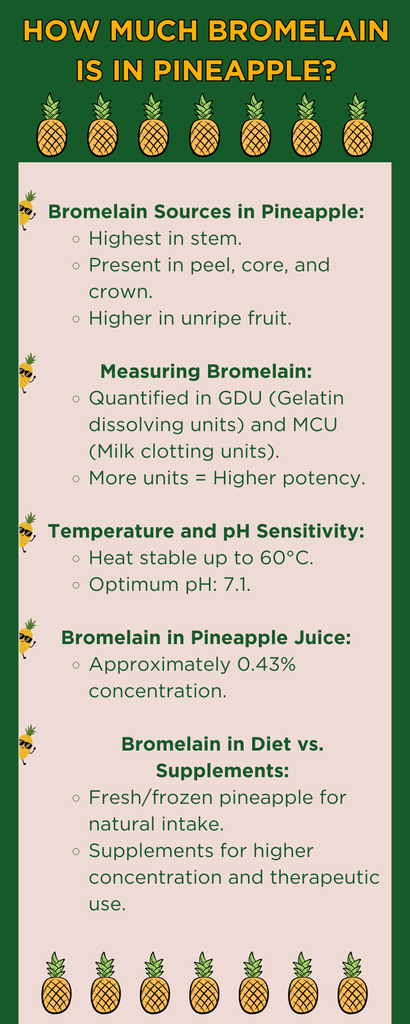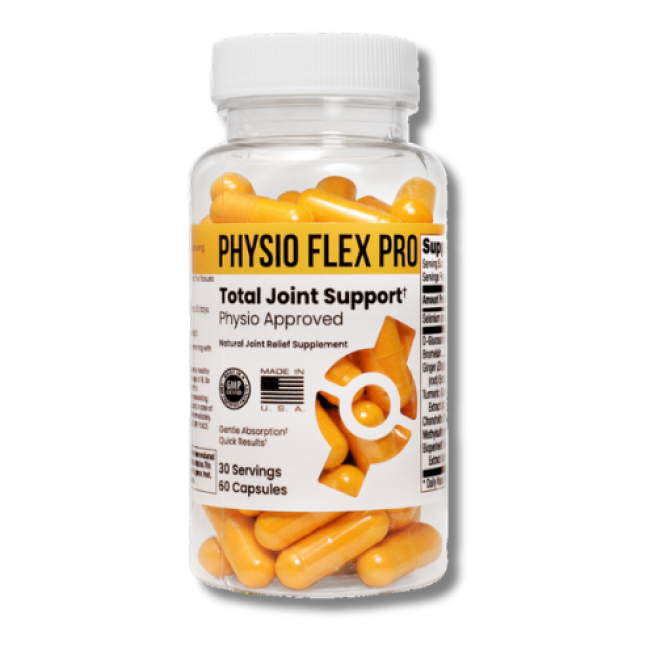Ever wondered how much bromelain is in a pineapple? This tropical fruit is a treasure trove of bromelain, an enzyme with numerous health benefits.
In this article, we'll uncover the amount of bromelain in pineapples and discuss its impact on your health. From aiding digestion to combating inflammation, get ready to discover the powerful effects of bromelain hidden in every bite of pineapple.
Quick Notes
-
Bromelain Concentration in Different Parts of the Pineapple: The stem of the pineapple typically has a higher concentration of bromelain compared to the fruit. The peel and core also contain bromelain, with one study showing high bromelain activity in the peels.
-
Variability Due to Fruit Maturity: Unripe pineapples have been shown to have higher proteolytic activity compared to ripe ones.
-
Measurement of Bromelain Content: Bromelain content is measured in Gelatin dissolving units (GDU) and Milk clotting units (MCU). The higher these units, the more potent the bromelain. For example, 1 gram of bromelain with 2000 MCU is approximately equal to 1 gram with 1200 GDU of activity.
-
Effect of Temperature and pH: Bromelain is heat stable up to 60°C, but temperatures above 70°C can inhibit the enzyme. The optimum pH for bromelain is around 7.1.
-
Bromelain Content in Pineapple Juice: One trial found that pineapple juice had a bromelain concentration of 0.43%, which is considered relatively high.
-
Comparison with Supplements: While eating fresh or frozen pineapples is a good way to consume natural bromelain, supplements provide a higher concentration of bromelain than can be obtained from the fruit alone.

What Is Bromelain?
Bromelain is a combination of proteolytic enzyme extracts derived from the stem and fruit of pineapples, which help break down proteins in the body or skin. Since bromelain has a high bioavailability, it effectively helps treat inflammation and swelling and has been commonly used as a pain relief agent in treating muscular, arthritic, and perineal pain.
Chemical Composition
Both stem and fruit bromelain are classified as glycosylated, monomeric single proteins with an isoelectric point (pI) value of 9.55 and an optimum pH range of 6–7. The proteins have about seven cysteine residues and three disulfide bonds.
Pineapple stems have a high bromelain concentration. However, studies show fruit bromelain has higher proteolytic activity and greater specificity than stem bromelain.
The following extraction methods are considered the most ideal and effective for deriving bromelain:
- Micropropagation process
- Reverse micellar system
- Membrane filtration
- Aqueous two-phase extraction
Foods like kimchi, yogurt, kiwifruit, and sauerkraut are particularly rich in bromelain.
The Health Benefits of Bromelain
Scientific studies recognize bromelain as a digestive aid. It can help improve digestion by breaking down proteins and promoting nutrient absorption, making it highly beneficial for people with digestive problems such as gas, bloating, or indigestion, making pineapple a popular remedy for constipation relief and overall digestive health.
Recent studies on serious sinus infections showed that bromelain helped achieve better relief and recovery from symptoms than standard treatments. Additional research showed that bromelain can minimize sinusitis-related cough and nasal mucus and the swelling and inflammation caused by hay fever.
Many physicians also laud the analgesic benefits of bromelain, especially in debriding wounds caused by surgical wounds or injuries. It also helps prevent blood coagulation and treats conditions like angina pectoris, bronchitis, sinusitis, and thrombophlebitis.
Studies show that Bromelain is beneficial in reducing arthritis symptoms and allows for better joint mobility, making it a safer alternative treatment for osteoarthritis patients. Bromelain also possesses powerful anticarcinogenic properties that can help inhibit tumor growth.
Contrary to popular belief, however, bromelain does not help break down fat, nor does its enzymes help lose weight, but it simply breaks down the protein the body receives from foods.
Bromelain in Pineapple: The Nutritional Breakdown
Variations in Bromelain Content
Apart from the fruit and the stem, bromelain can also be found in the pineapple’s peel, core, and crown. However, most studies show that the stem has a higher concentration of bromelain than the fruit, making it the more available and abundant source of bromelain. Since the stem is a waste by-product, extracting bromelain from the stem is more inexpensive compared to fruit bromelain, which is often used as a food product.
One study also showed that pineapple peels showed a high bromelain activity of 229.64 CDU/ml with the crown and 246.83 CDU/ml without.
The following factors can affect Bromelain's catalytic activity.
- Temperature – While bromelain is normally heat stable up to 60°C, a temperature of 70°C can inhibit the enzyme and cause inactivity, rendering the enzyme unable to initiate proteolysis.
- pH levels – The optimum pH of the enzyme is 7.1, while the most stable pH range is 3.9-4.2
- Fruit maturity - Studies show that unripe pineapple fruits [1.9101 ± 0.0831 U/mL] had higher proteolytic activity than the ripe ones.
Measuring Bromelain Content
Gelatin dissolving units (GDU) and MCUs (milk clotting units) measure an enzyme's protein digestion and show how much protein an enzyme can digest in a specific time under specific conditions. The GDU is usually specified by gram weight – the higher the GDU, the more potent the product is (One GDU = approximately 1.5 MCU)
One gram of bromelain standardized to 2000 MCU would be approximately equal to 1 gram with 1200 GDU of activity or 8 grams with 100,000 rorer units (RU) of activity.
Bromelain Content in Pineapple: A Deep Dive into the Data
Additional Scientific Studies on Bromelain
In various studies regarding bromelain content in pineapples, one study found that bromelain’s enzyme activity was lowered when it was freeze-dried, showing that bromelain shows maximum enzymatic activity at higher temperatures (not exceeding 65°C). Its activity decreased at low pH levels.
One trial managed to source relevant amounts of biologically active bromelain from pineapple cores, often the most significant waste materials in producing pineapple-based food products. The study also found the same peptidases are present both in the core and the pulp.
Various studies also prove that the stem bromelain exhibits more enzymatic activity than fruit bromelain. One study showed that the crude fraction of stem bromelain obtained from centrifugation at 2,000 revolutions per minute (RPM) possesses better proteolytic activity than fruit bromelain collected at 6,000 rpm.
Different bromelain sources may have their own unique properties; stem bromelain facilitates better recovery from injuries and relieves stomach problems; fruit bromelain strengthens the immune system, while peels can help with intestinal parasites.
How to Maximize Bromelain Intake from Pineapple
The optimum temperature for storing pineapple bromelain is 35-55 °C, with the maximum operating temperature of use being 60º C. Exceeding these temperatures inhibits the enzyme and causes it to become inactive, rendering it unable to initiate proteolysis.
Eating pineapple (fresh or frozen) is the best way to consume natural bromelain; in contrast to canned pineapples, the canning process kills the bromelain enzymes to make them sweeter.
However, consuming pineapple alone will not provide enough bromelain as a standalone medical treatment for injuries and other conditions. Bromelain supplements are often prescribed to yield stronger and better results without completely substituting pineapples as a natural bromelain source.
Dosages
Bromelain supplements can be taken as high as 400 mg thrice daily, depending on the healthcare provider’s prescription on the condition you’re taking bromelain for. Greater and more frequent dosages are often prescribed for more severe conditions.
Bromelain generally starts working once in the stomach within an hour of ingestion. There, it breaks down food nutrients and helps the body digest and absorb them faster and more efficiently.
While its effects aren’t instantly apparent, long-term and consistent bromelain supplementation increases its effectiveness and assures better, equally long-term results and health benefits.
Potential Risks and Considerations
Common Side Effects
Here are some of the more common side effects attributed to bromelain
- Stomach upset
- Diarrhea
- Increased heart rate
- Menstrual problems
- Allergic reactions (especially among those with pineapple allergies)
People with pineapple allergies should avoid taking bromelain and seek alternative supplement options. Pregnant women and people with bleeding disorders, high blood pressure, and liver or kidney disease should also avoid bromelain.
Bromelain can also potentially increase the risk of bleeding during and after surgical procedures. Stop taking bromelain at least 2 weeks prior to surgery.
Interactions
Bromelain is known to interact with the following drugs/medications:
- Antibiotics (e.g., phenoxymethylpenicillin, flucloxacillin, amoxicillin. etc.)
- Anticonvulsants.(e.g., gabapentin, topamirate, valproic acid, etc.)
- Antidepressants (e.g., SSRIs, imipramine, trimipramine, etc)
- Barbiturates (e.g., phenobarbital, primidone, secobarbital, etc.)
- Blood thinners (e.g., warfarin, aspirin, dabigatran, etc.)
- Sedatives (e.g., diazepam, ketamine, lorazepam, etc.)
Dosage Recommendations for Safe Usage
Dosages often range from 80 to 400 milligrams per serving (sometimes as high as 2000 mg, depending on the condition), usually two to three times daily. Your doctor may recommend taking bromelain with meals to aid digestion and increase effectiveness, but it can also be taken without a meal, depending on a person’s condition.
When in doubt or if you’re having problems with dosages and supplementation, consult with your healthcare provider to adjust the dose for you or help with any side effects.
FAQs on Bromelain in Pineapple
1. How much bromelain is in a cup of pineapple juice?
One trial showed that (a cup of) pineapple juice had a bromelain concentration was 0.43%, which is relatively high.
2. Can I get enough bromelain from eating pineapple alone?
Eating fresh or frozen pineapples is the best way to get natural bromelain;
However, regular consumption will not provide enough bromelain to have a high enough concentration to be effective, so it’s best to use bromelain supplements in conjunction with including pineapples in one’s diet.
3. Does cooking pineapple affect its bromelain content?
Yes, cooking pineapple does affect its bromelain content. Bromelain is a heat-sensitive enzyme, and cooking or heating pineapple typically reduces or destroys its bromelain content.
Bromelain is normally heat stable up to 60°C, but going beyond 70° can inactivate and inhibit the enzyme, which won’t be able to initiate proteolysis.
4. Are there any interactions between bromelain and medications?
Bromelain interacts with antibiotics, antidepressants, anticonvulsants, barbiturates, and sedatives.
5. How does pineapple compare to supplements for bromelain content?
Bromelain supplements provide higher concentrations than just by consuming pineapples. However, eating pineapples should never be set aside completely and should still be part of a healthy diet.
Conclusion
Bromelain is prized and sought after for its powerful therapeutic, anti-inflammatory, and analgesic properties, which have been studied and proven by scientific research. Factors like temperature, fruit maturity, source material, and preparation methods can affect bromelain potency and enzyme/proteolytic activites
Always consult a healthcare professional before starting any new supplement or treatment to discuss their long-term effects on your health. You can also ask a dietitian how to effectively include pineapples in your regular diet.






